
What is the Nordic diet?
Peer reviewed by Dr Krishna Vakharia, MRCGPAuthored by Victoria RawOriginally published 22 Nov 2024
- DownloadDownload
- Share
- Language
- Discussion
The Nordic diet originates from the traditional eating habits of regions in northern Europe and the North Atlantic. These colder countries share a dietary approach of locally grown plant-based foods and responsibly sourced game meats. It’s sometimes called the Scandinavian diet, but whichever name you know it by, let's take a look at what it involves, along with its potential health benefits.
In this article:
Continue reading below
What does the Nordic diet involve?
The Nordic diet focusses on foods that are locally sourced and seasonal, reflecting the harsh climates of Nordic countries, Denmark, Finland, Iceland, Norway, and Sweden.
Deborah Grayson, Pharmacist and Nutritional Therapist, Practice With Confidence explains that the Nordic diet is all about eating what grows naturally in the region, which promotes sustainability and reduces environmental impact.
"For example, root vegetables - such as potatoes, turnips, and carrots - are a key component in colder months," she says. "While berries - such as lingonberries and cloudberries - are plentiful in summer."
It also has a unique emphasis on traditional food preservation methods such as pickling and smoking.
What is the Nordic diet?

Graphic: Ben Hudson
What foods can you eat on the Nordic diet?
The Nordic diet's main elements overlap with other well-known diets such as the Mediterranean diet. However, it differs in its reliance on colder-climate foods such as root vegetables, game meats and seasonal foods.
Grayson outlines the Nordic diet's main components:
Wholegrains - such as rye, barley and oats, which are a rich source of fibre and packed with essential nutrients.
Oily fish - salmon, herring, mackerel, and trout are staples in the Nordic diet. These fish are rich in omega-3 fatty acids, which are good for your heart.
Root vegetables - vegetables such as potatoes, carrots, turnips, and beets are commonly eaten. These provide fibre, vitamins, and minerals.
Berries - typically lingonberries, bilberries, cloudberries, and raspberries. These berries are high in antioxidants and vitamins.
Dairy - dairy is an important part of the Nordic diet, with yoghurt, Skyr (Icelandic yoghurt), and cheese being frequently consumed. These foods provide calcium and protein.
Lean meats and game - in moderation, lean meats such as chicken and pork are eaten. Game meats such as venison or reindeer may also be part of traditional meals in Nordic countries.
Nuts and seeds - walnuts, almonds, flaxseeds, and sunflower seeds are included as sources of healthy fats, protein, and fibre.
Healthy fats - the Nordic diet emphasises fish oils, rapeseed oil, and butter in moderate amounts, contributing to a balanced intake of fats.
Seasonal and local produce - emphasis is placed on eating seasonal and locally grown fruits and vegetables, which may include cabbage, apples, and leeks in the colder months.
Continue reading below
What foods should you avoid on the Nordic diet?
The Nordic diet prioritises fresh, seasonal and whole foods, while minimising or cutting out processed foods, sugary snacks and refined grains.
Grayson says: "The focus is on healthy fats from fish, oils and nuts, whilst limiting processed meats, trans fats, and high-sodium foods."
It also encourages you to reduce alcohol and dairy consumption, while cutting back on artificial ingredients or additives.
Is the Nordic diet good for weight loss?
The Nordic diet can support healthy weight loss by encouraging you to eat healthy, low-calorie foods such as vegetables, berries and lean proteins.
Grayson explains that the fibre-rich foods in the Nordic diet help with digestion and make you feel full for longer. The healthy fats from fish and rapeseed oil will support your metabolism and curb your hunger.
"Fill your plate with non-starchy vegetables such as leafy greens, cabbage, carrots, and cruciferous vegetables like broccoli and cauliflower," she says: "Although whole grains like rye bread are healthier than processed foods, they should be consumed in moderation if weight loss is your goal, as they can still be high in calories."
Continue reading below
What are the benefits of the Nordic diet?
A diet that promotes a balance of lean proteins, healthy fats and complex carbohydrates is generally good for your wellbeing.
The Nordic diet in particular is associated with a range of health benefits.
Grayson says these include:
Improved heart health.
Weight management.
Blood sugar control.
Reduced inflammation.
Better gut health.
However, although it's associated with various wellness advantages, the Nordic diet - as with any diet - requires a careful and considered balance of nutrients.
For example - Grayson warns that if you eat more of the plant-based and less of the protein components, you may become deficient in vitamin B12, iron or calcium. Similarly, eating too much fish can potentially expose you to higher levels of mercury. Two oily fish portions per week are generally considered safe.
"Failure to balance portion sizes can also cause issues with higher consumption of fats and calories," she adds.
You don’t have to be a Nordic native to enjoy Scandinavian-inspired cuisine. Explore these meal examples for a delicious and balanced day inspired by the Nordic diet.
For breakfast: hearty and wholesome oatmeal bowl
Ingredients:
Rolled oats.
Water or milk - preferably from a local dairy.
Mixed berries - such as blackberries, blueberries and raspberries.
Chopped nuts - such as almonds and walnuts.
Add local honey to taste.
For lunch: smoked haddock and poached egg on wholemeal toast
Ingredients:
2 slices wholemeal bread.
2 large eggs.
1 wild caught smoked salmon fillet.
1 tablespoon of butter.
Fresh dill.
Add pepper to taste.
For dinner: roasted chicken with root vegetables and brown rice
Ingredients:
Free range chicken seasoned with pepper and fresh thyme - roast with wild garlic.
Root vegetables - such as carrots, parsnips and potatoes - toss with pepper and hazelnut oil.
Brown or wholegrain rice.
By reducing the intake of processed foods, refined sugars, and saturated fats, the Nordic diet can help prevent and manage long-term diseases, support cognitive function, and improve overall health.
Grayson says: "This diet is highly flexible and, with small adjustments, can be adapted to suit various dietary needs and preferences. Whether you're following a plant-based diet, need gluten-free options, want to control blood sugar, or are trying to lose weight, the foundational principles of the Nordic diet can be tailored to support your health goals."
What is the Nordic diet?
Article history
The information on this page is peer reviewed by qualified clinicians.
Next review due: 22 Nov 2027
22 Nov 2024 | Originally published
Authored by:
Victoria RawPeer reviewed by
Dr Krishna Vakharia, MRCGP

Ask, share, connect.
Browse discussions, ask questions, and share experiences across hundreds of health topics.

Feeling unwell?
Assess your symptoms online for free